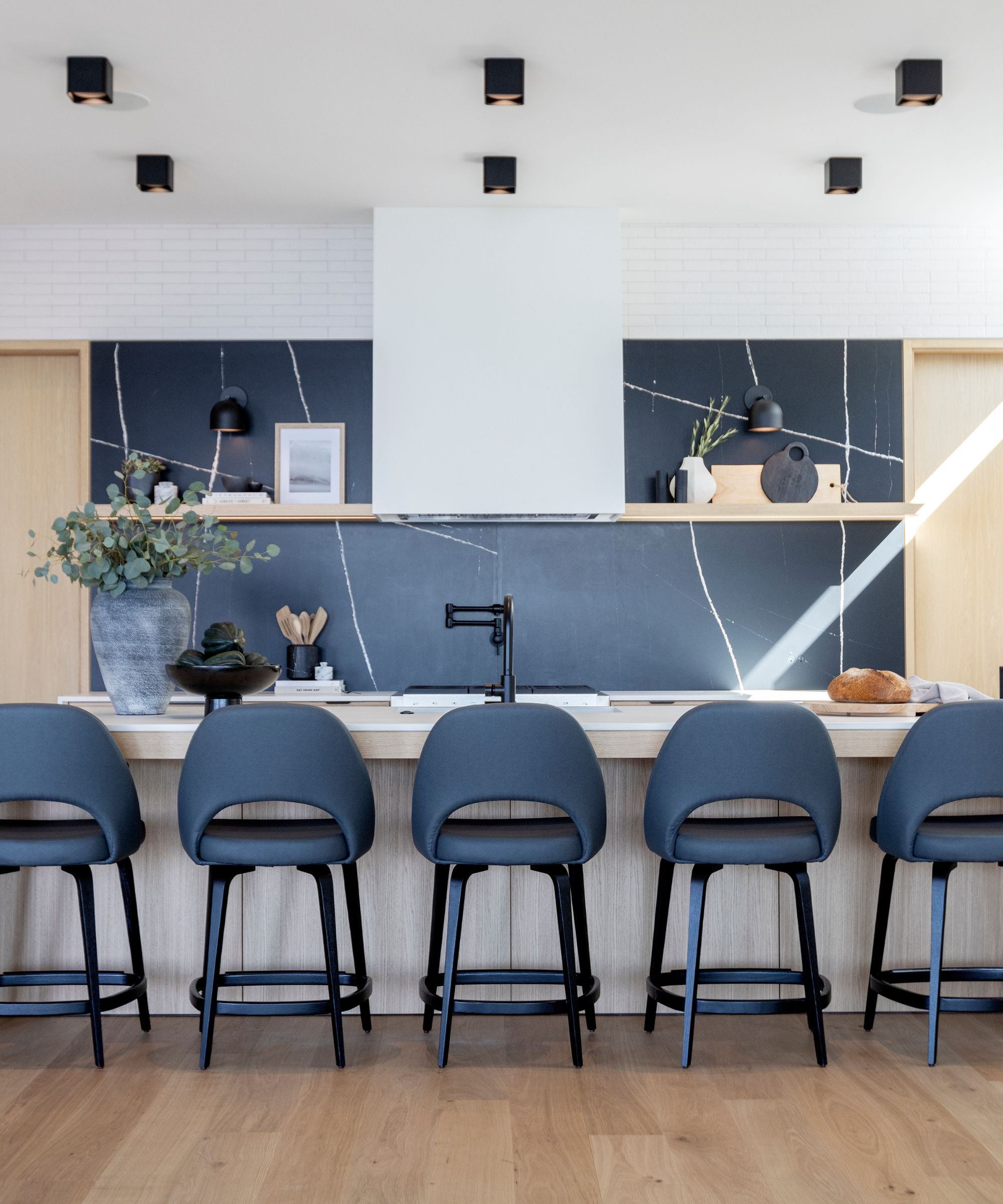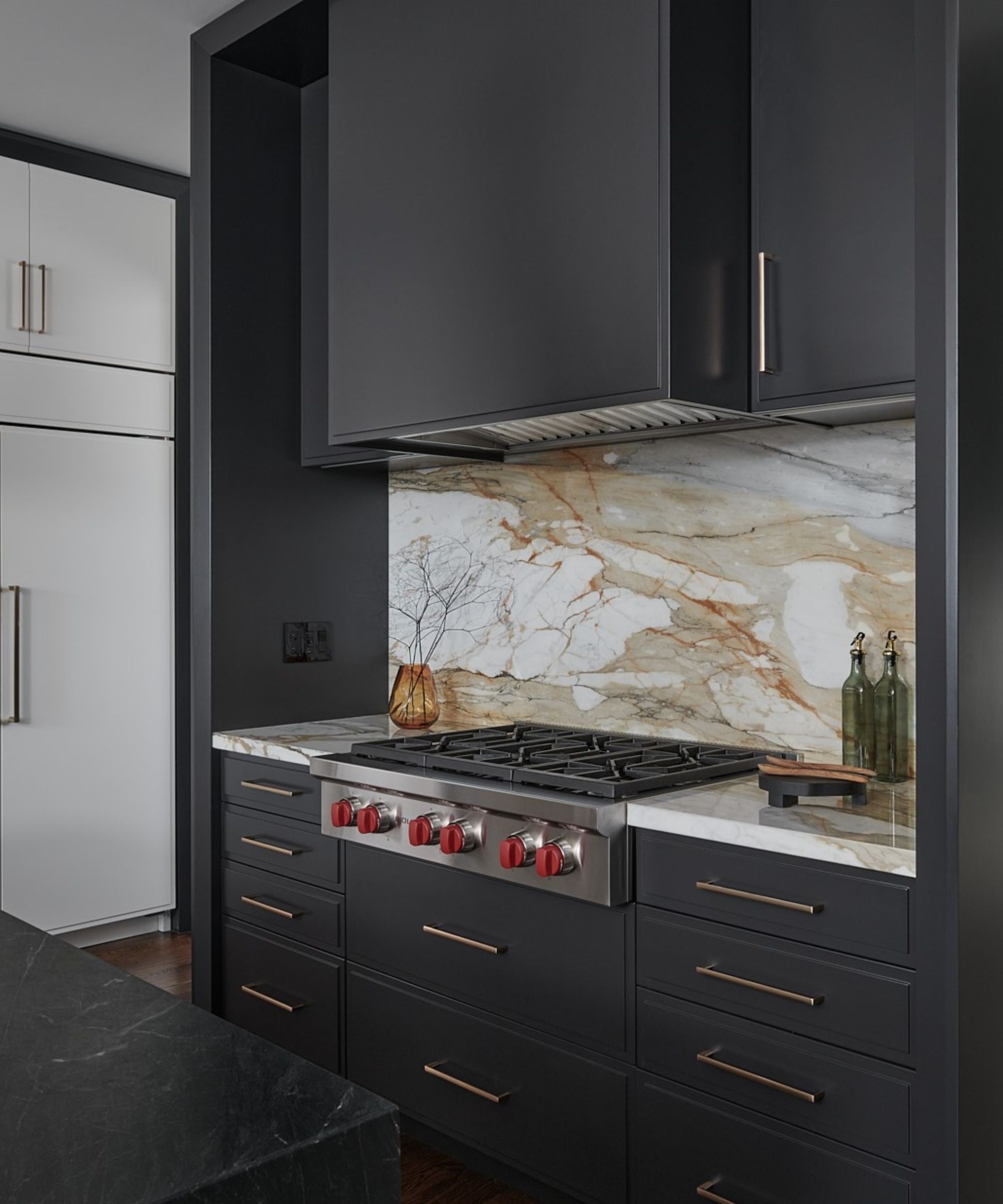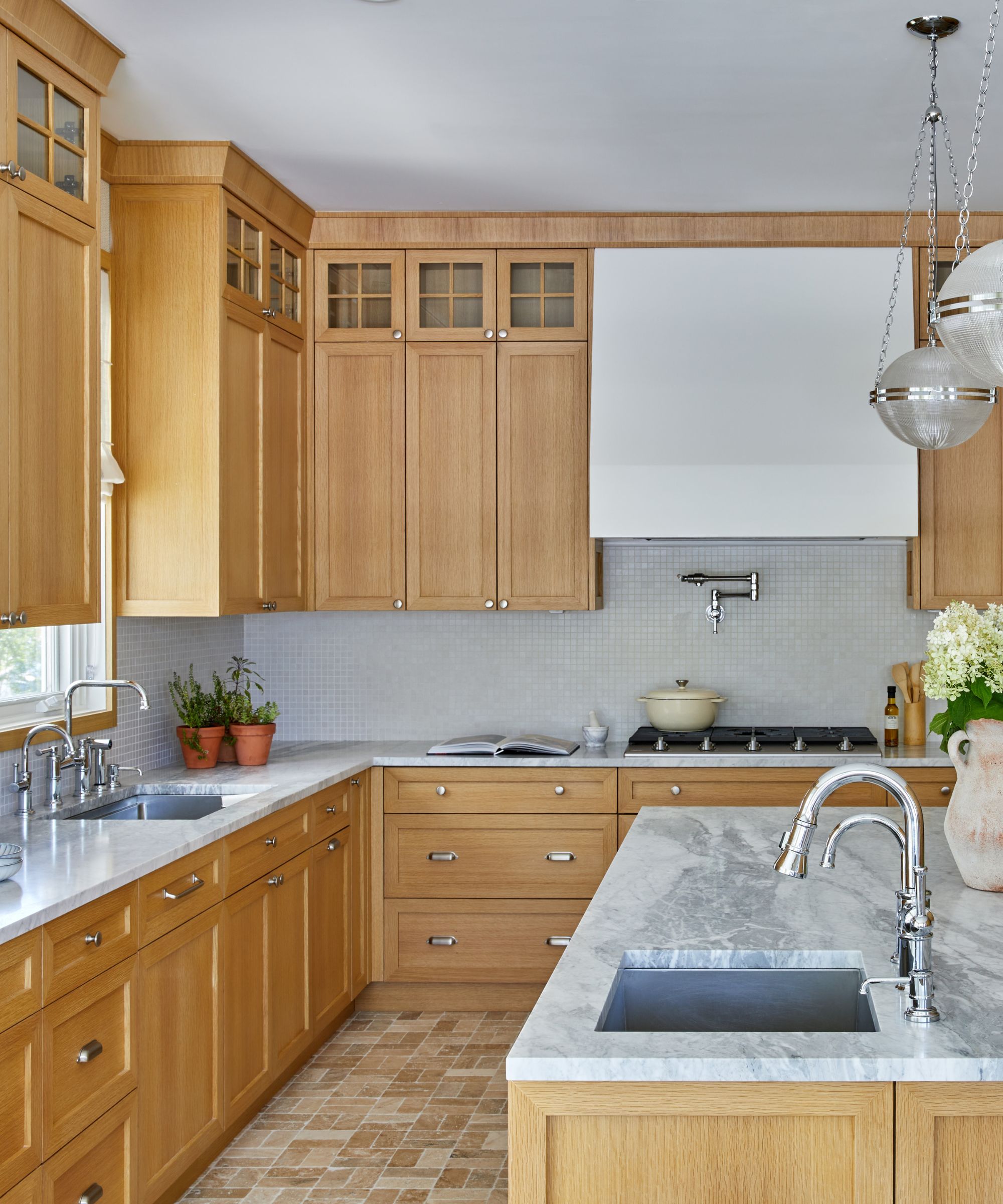Don't want to hide your range hood? This is how interior designers make range hoods defining features in any kitchen
This functional feature doesn't have to bring your design scheme down. Here are eight tips from interior designers who say the range hood deserves to steal the show

- 1. Consider size and scale
- 2. Create symmetry in your space
- 3. Experiment with unique shapes
- 4. Blend with existing architecture
- 5. Go blended or bold with your color scheme
- 6. Get creative with materials and textures
- 7. Make it functional
- 8. Use a range hood to create contrast
- 9. Customize your design

Functional by nature, range hoods tend to stand out – and not for good reason. They're often an afterthought and don't often spark loads of design inspiration. But designers say the range hood has come a long way – now, this feature can hold its own amongst all the other accessories that make kitchen designs shine.
With unique shapes and stunning finishes, you now have the opportunity to make your range hood reflect your personality and make a statement in the kitchen. We spoke with interior designers to gather their top eight tips for making a range hood the stand-out feature in your kitchen, no matter your design style. Here's what they had to say.
How to make a range hood is chic as well as practical
Range hoods don't need to be hidden away anymore – this is how the experts make the functional feature shine in any space. From eye-catching materials to bold, contrasting colors, the range hood might just be your favorite part of the kitchen.
1. Consider size and scale

Before deciding on a statement range hood, it's important to assess your kitchen's layout and existing design. Even if your goal is to make the hood stand out, letting it take over the rest of the space will derail your entire design scheme. Shaunn Lipsey, principal designer and creative director of Shaunn Lipsey + Co., says that 'considering size and scale' makes all the difference.
'Ensure the size of the range hood is proportionate to the size of your cooking area and kitchen. A large hood in a small kitchen can overwhelm the space, while a small hood in a large kitchen might not make much of an impact,' she says.
Once you've determined what size makes the most sense for your space, be thoughtful about the range hood's style. Shaunn says that if you're going for a 'distinctive design,' it should still complement the rest of your kitchen decor so it doesn't stand out for all the wrong reasons.
2. Create symmetry in your space

Aside from size and scale, the range hood's placement within the kitchen is of the utmost importance if you'd like it to steal the show. Trish Knight, interior designer and co-founder of Vancouver-based Knight Varga Interiors, says beginning with a symmetrical layout goes a long way, allowing you to build out the rest of the kitchen with the range hood's placement in mind.
Design expertise in your inbox – from inspiring decorating ideas and beautiful celebrity homes to practical gardening advice and shopping round-ups.
'When using a hood fan as the defining feature in a kitchen, we typically start by creating symmetry with the range centered on a wall, and building out cabinets equally to the left and right,' she says.
To ensure that other kitchen appliances aren't pulling attention away, Trish adds that she likes to panel appliances in millwork to 'minimize the look and size' of these features while 'drawing the eye back to the hood fan.' She suggests taking note of your home's overall style to inform your approach.
'In a traditional home, the hood fan cover will be embellished with moldings, and often curved, but still flanked by upper cabinets to each side. In a more modern application, we often eliminate the upper cabinets in favor of simple decorative shelving and a bold backsplash material,' says Trish.
Brandon Lange, creative director and principal designer of BZ Interiors, adds that leaving room on either side of the range hood creates space for unique design features.
'Leaving space around the sides of the range hood rather than directly butting to cabinetry on both sides will allow for decorative wall sconces to be included, or for a wall tile or other wall treatment to extend up to the ceiling,' he says.
3. Experiment with unique shapes

Though range hoods have taken on predictable shapes for quite some time, designers say you don't have to stick to a simple rectangle or funnel shape. Artem Kropovinsky, interior designer and founder of Arsight, says a range hood in a unique shape can even become an 'unusual architectural feature.'
'Imagine sculptured or geometric forms which draw attention and create a piece of art in themselves. In a modern, minimalist-style kitchen, the angular design of a hood will enhance the clean lines of the space, while a curved or ornamented hood can be used in a more traditional and opulent setting,' he says.
But you don't need to match the rest of your kitchen directly – sometimes, creating contrast is just as impactful. Eugenia Triandos, principal designer of Montreal-based Hibou Design & Co., suggests 'playing around with shapes and textures' when it comes to the range hood.
'If your kitchen has square corners, you could opt for a more rounded hood – this will exude its own distinct personality, setting the tone for your kitchen space. As long as it resonates with the design language of the entire kitchen design, do not be afraid to let your hood range exude its own personality,' she says.
Brandon suggests custom range hood inserts for a show-stopping look. He says this trick allows you to construct 'housing' for the range hood 'in any shape or material of your choice,' while unnecessary parts of the appliance are stowed away. 'This then allows for an opportunity to introduce an unexpected shape or material to your kitchen.'
4. Blend with existing architecture

'For kitchens with scale, we feel it’s important that key elements, such as the range hood, match that scale and integrate into the architecture of the space,' says Matthew White, interior designer and co-founder of New York City-based White Webb.
In this kitchen, pictured above, the thoughtfully designed range hood draws the eye immediately. Inside a 'sprawling 1920s hacienda in California,' the appliance is covered in handmade tiles from Mexico – and the result is stunning. Despite the expansive ceiling with inset skylights and dark wooden cabinetry, attention is pulled straight toward the tile.
'To draw a connection with the remainder of the space, we extended the neutral kitchen tiles from the design onto the gorgeous barrel-arched ceiling,' adds Frank Webb, interior designer and co-founder.
5. Go blended or bold with your color scheme

Richard Davonport, managing director of Davonport, agrees that hiding the range hood has been the norm for some time: 'Whether hidden behind cupboards or in floating ceilings, there has been a feeling that a range hood doesn’t fit with the contemporary or classical shaker kitchen designs that have been popular,' he says.
But Richard adds that 'this doesn't work in all kitchens,' suggesting instead that the range hood should embrace the rest of the kitchen's design scheme. Matching the range hood with the rest of the kitchen's color scheme is one way to ensure the whole space flows.
'In this kitchen, the range hood works with the brick walls to create an industrial vibe that counters the sleekness of the shaker cabinet lines. This naturally creates a feature of the range and range hood to showcase its true potential,' says Richard.
Shaunn agrees, saying that 'complementary materials, colors and finishes' contribute to an all-around cohesive look in the kitchen. But if you're in the mood for something a bit more bold, choosing a bold color that contrasts with the rest of the room can lead to a stunning range hood as well.
'The range hood painted in a vibrant color that contrasts with the kitchen’s palette can act as a pleasing, happy surprise. This is especially applicable in the monochromatic and neutral kitchens, where the hood is indeed a burst of color,' Artem adds.
6. Get creative with materials and textures

Non-traditional materials and textures also take an average range hood to the next level. In this kitchen, pictured above, Jessica Cinnamon Design, chose a sleek, black metal for the range hood and created contrast with a veined, neutral marble kitchen backsplash.
'We like to design our hoods to be larger than our oven to give you more of a visual impact in the space. Consider cladding your hood in stone, or add a stone detail on the hood. Incorporate contrasting materials like metals to bring more visual impact to the shape of the hood,' says Jessica, principal designer and founder.
Eugenia also suggests stone finishes, and adds plaster to the list of trending yet timeless materials that make a range hood sing: 'This will elevate its aesthetic appeal, while scaling it up to make a bold statement,' she says.
Erika Soza-Meija, principal designer at Florida-based Concept 2 Design, says 'range hoods have come a long way.' She says getting creative with the materials you're using on the range hood has the potential to add character and charm to the kitchen's overall design.
'For example, for a waterfront property, we used a leathered limestone that has a natural and textured appearance – resembling shells and contributing to the coastal decor nods we were aiming for in this project,' says Erika.
In another project, Concept 2 Design wanted a brass look on a budget, so opted for a brass laminate: 'We then added a black trim with exposed screws for an industrial aesthetic. The result is a striking and modern range hood that draws attention,' she adds.
7. Make it functional

Though a range hood is by definition function-forward, designers suggest leveling up the feature by adding additional elements of practicality. In this kitchen, Chris Spink – founder of Hush Kitchens – says a 'full mantle' range hood design adds playful, geometric design to the space while incorporating some unexpected storage.
'The hand-painted mantle shelf is an attractive architectural feature that can be used to display decorative items. The "cook’s shelf" behind the range is a useful place for utensils, oils, and seasoning, he says.
8. Use a range hood to create contrast

In this kitchen, designed by Natalie Kraiem Interiors, functionality and aesthetic appeal came into equal consideration. Natalie Kraiem, design and project director, says she sought contrast in this space, opting for 'shaker-style white oak cabinets' and a range hood in white lacquer. By installing a high-end ventilation system from Dacor alongside the statement design, she ensured the range hood is working for the client – it's more than simply nice to look at.
'The hood not only catches the eye but also enhances the cooking experience. While the visual impact was a key factor in the design of this bold hood, functionality was equally important,' says Natalie.
For another added touch of functionality, Artem suggests integrating lighting into the range hood's design: 'Strategic lights may accentuate the features of the hood and also serves as task kitchen lighting for the cooking area. This can be done by using LED strips along the sides or under the hood, or by incorporating spotlights or pendant lights,' he says.
9. Customize your design

While there's a wide range of eye-catching range hoods on the market, working with an interior designer or manufacturer to create a range hood that's customized specifically to your space will ensure it's the perfect size and shape.
'If you want a unique and personalized range hood, you can work with a hood fan company to design one that suits your taste and budget. There are tons of options and finishes to choose from,' says Erika.
When opting to go bespoke, you'll also have the option to add features like decorative rivets and engravings 'to reflect your personal style and add a touch of sophistication to the kitchen,' adds Shaunn.
With fresh ideas for materials, colors, placements and shapes, your range hood will never have to be hidden again. Let the range hood shine, front and center, and the rest of your kitchen design will follow suit.

Abby was the Interior Design News Editor at Homes & Gardens and is now studying for her Master's degree in Journalism at City University, London. Prior to joining our team, she worked with Better Homes & Gardens, where she wrote and edited content about home decor, gardening tips, food news, and more. She studied Journalism and English Literature at New York University and moved to London to pursue her love of writing in 2023.


